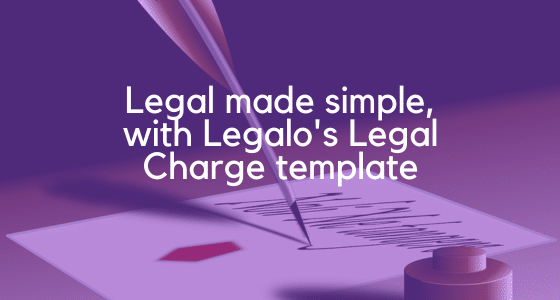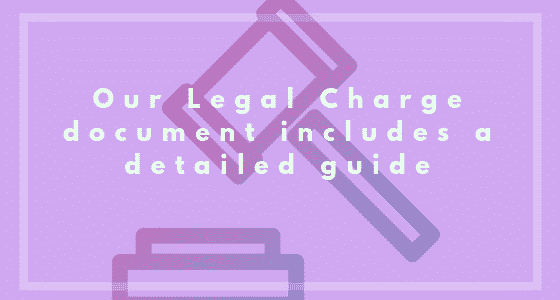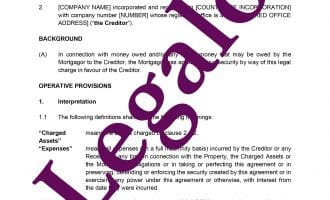Legal Charge Document
Our Legal Charge template:
- A legal charge over UK property
- Charge template drafted by a UK solicitor
- Clear plain English for easy understanding
- Over 300 sold!
- Average editing time of 15 minutes

How Does It Work?
-
1. Download
-
2. Edit
-
3. Print
-
4. Sign
Our Legal Charge document template is for use where a creditor is to take a form of security over the assets of a debtor (in this case the asset being property). Use this charge where the security is either freehold land or long-leasehold property within the UK. It is often known as a legal charge on property.
Drafted by our co-founding solicitor, David, he has written the template in clear plain English.
Now over 300 sold!
This Legal Charge document template incorporates various options, so it is appropriate where:
- the property is in the UK;
- the property is either registered land at the Land Registry or unregistered land;
- the debtor is a company or an individual;
- you have the debtor’s agreement to register this charge; and
- the creditor is a company or an individual.
Included with the document download is a detailed guide to completing the template. Please don’t try and use this document for security over property that is not located in the UK, as it probably will not be valid or effective.
If you have not already got a loan agreement, see our discount package giving a 20% discount when you buy both together. Our legal charge template is intended for use with a secured loan agreement.
Guide included
The document template is downloadable in Word format. Once downloaded, please read the guide that comes with it and then edit the document template to create your final document. You edit the document on your computer just like you would complete a form. Simply fill in the blanks and choose from the various options. The helpful guide will lead you through exactly what you need to do.
The guide notes that you then register the legal charge with the Land Registry. For full details on how to register the charge, please see the Land Registry website.
When to use a Legal Charge Document
The template is suitable for putting in place a charge against UK real property, i.e. land. You do this by taking security over residential or commercial property that is either freehold land or a long leasehold property.
If the property is leasehold you ideally want a “long leasehold” property. We mean property for which the owner paid a significant premium to purchase the lease or its remaining term. This ensures that the lease has value which becomes important if you need to exercise the security. Why? Well, because, if you do have to enforce the legal charge, you will then need to sell the property.
Any other types of lease will not be as good security, as the lease will not have a resale value. You would not take security over a normal commercial lease (i.e. one where the tenant pays a substantial amount of rent each year), as such a lease is more of a debt than an asset. It would not make for good security and you could find yourself taking over the burden of paying significant rent each year.
When using this as a second legal charge
Ideally, you would use this Legal Charge document as a first legal charge. That gets you the best security for your loan. However, if you are using it for a second legal charge, you will nearly always need the consent of the first charge holder to register your second legal charge. There is also a risk that they insist that you use a firm of solicitors to do this work for you. So if that could be the case, please check before you purchase our templates.
As a second charge holder, if the first charge holder lends more to the borrower it would erode your equity. There is nothing to stop this, unless you enter into a Deed of Priority (we do not currently offer this template) with the first charge holder to prevent it.
If you don’t know (a) if there is a first legal charge (i.e. an existing mortgage in place), or (b) whether the first chargeholder’s consent is required before you can register a second legal charge, then you can search the property at the Land Registry. This is done most easily if you have the title number of the property. You can then carry out a Land Registry search for a very small fee here: https://www.gov.uk/get-information-about-property-and-land/search-the-register.
Legal Charge -v- Mortgage
People also call this sort of legal charge a mortgage. It works like a bank mortgage and ultimately gives the creditor the power to sell the property in question to recover the money owed. This happens if the debtor has defaulted, for example in the repayment of a loan owed to the creditor.
This Legal Charge document also works to secure a guarantor’s obligations, if needed.
In this template please treat references to the mortgagor or debtor as references to the guarantor if you are using the legal charge in this manner. Effectively the guarantor will be standing in the shoes of the original debtor to the extent of the guarantee. If you need a template for a guaranteed loan agreement, then Legalo has one available.
Legal Charge -v- CH1 form
The CH1 form from the Land Registry is a type of legal charge. Effectively, the CH1 is an abbreviated legal charge.
However, we recommend you don’t just use the CH1 form. The reason for this is that the CH1 form of legal charge does not have the same extra rights and powers that a full legal charge (like the Legalo template) does.
Banks take a full legal charge and would not rely on the abbreviated powers and rights in the CH1 form. We suggest you do likewise.
When to take security
If as a lender you think you might need security for your loan at any point, it is best if you take it at the point that you make the loan. When it is taken later on, after the loan has been made, it can be held to be invalid in certain circumstances if taken against a company or someone who goes bankrupt shortly after the security has been given. Specifically if the company goes bust, any legal charge that was put in place after the loan was entered into can be declared to be void.

Legal Charge Documents and Loan Agreements
We intend for you to use the legal charge in conjunction with a separate loan agreement. Effectively, you set out the terms of the loan (repayment, interest, etc) in the loan agreement, and then the legal charge simply provides the security for that loan.
You may be intending to use this legal charge in conjunction with one of our loan agreement templates, in which case, please use either:
- our Secured Loan Agreement template; or
- if you want to buy the two templates together at a 20% discount, see our combined discount package here.
Ideally, the loan will be made and the security given by the borrower at the same time, so you should sign and date both documents at the same time. (There’s more of an explanation of why this is best in the guides that come with the documents.)
Register the legal charge once completed using a CH1 (or K1) form from the Land Registry (available free of charge from them, but there is a registration fee). This Government guide on registering charges takes you through the steps and links to the form that you will need. We don’t deal with this aspect, so look at the Land Registry website as to what you need to do.
Along with the CH1 form, you will need an AP1 form and ID1 forms for the parties who are not using a solicitor. ID1 forms need to be sworn in front of a solicitor or notary public. If you cannot find a local solicitor to help you. then a better bet is usually a notary. You can find notaries local to you on The Notaries Society website.
Independent Legal Advice on Charges
If a person that is not the actual debtor (or if more than one person, where not all of them are the original debtor(s), e.g. a guarantor) is providing the charge, then the creditor has a duty to check that there is no “undue influence”.
The most common situation here is of a husband borrowing money to fund his business (which is perhaps a separate company) and he gives security over the family home to secure the loan. In this situation, his wife’s consent would be needed (whether or not she is on the title deeds to the home) and she will need to be given independent legal advice by a solicitor so she knows what she is doing and is not forced into it by her husband. However, it is also for the benefit of the lender, such as a bank – the bank then knows she has had the proper advice and she cannot later say the bank failed in its duty to her to see that she took independent legal advice.
This also applies where there is more than one owner of the property if only one is the borrower. For example, where one of the owners borrowed the loan or incurred the debt being secured and it was not for the benefit of the other. (If two people are buying a new property together and both are borrowing the money to fund their joint purchase, this issue is not relevant.)
Certificate of having given independent legal advice
So, in summary, if this applies, the creditor should ensure that (a) the person takes independent legal advice and (b) the legal adviser to that person signs a letter to the creditor to certify that the adviser has given such advice and is happy the legal charge is binding on the person and that they were not under the “undue influence” of anyone else (usually the borrower) when signing it.
Legalo has a template for the form of certificate required in this case.
FAQs on Legal Charges
Below we answer some of the most common questions from the Internet about legal charges.
What is a legal charge form?
A legal charge is a security to secure the repayment of a debt (or secure another obligation), which you hold (or register) over a valuable asset: freehold or long leasehold land.
What is a first legal charge on a property?
A first legal charge is the best security you can get on a freehold or long leasehold property in the UK.
How do I create a charge on my property?
You use a legal charge template like Legalo’s, and this makes it simple. Then you register it at the Land Registry over the property in question.
How do you put a charge on a property in the UK?
If you are putting a first charge on your own home in favour of someone else, you just sign a legal charge and give it to them to register at Land Registry. If it is a second charge, then you will normally need the consent of the first charge-holder (e.g. the bank).
When you want to put a charge on someone else’s property, you need their consent and the consent of any existing charge-holders. If you cannot get their consent, then you will need a court order in order to impose a charge on someone else’s property. You will first need to prove they owe you money, so you may need to sue them before you can get a charging order form the court.
Can you put a charge on someone’s house?
You can do this either:
-
with their consent (i.e. they sign a legal charge in your favour); or
-
with a court order, e.g. if you have sued them successfully in court, obtained a court judgment that they owe you money, and then you enforce that court order initially by registering a charge over their property.
Otherwise, you can’t simply stick legal charges on people’s houses just because you want to or just because they owe you money.
What happens when you put a charge on a property?
When you put a charge on a property, you need to register that charge at the Land Registry. Send off the forms, pay the fee, and the Land Registry should register your charge in a few months’ time.
How do you enforce a charge on a property?
If you have a legal charge, it normally contains provisions allowing you to take possession of, and sell, the house without needing a court order. If there are people living there, you may still need an eviction order from the court, so that you can sell the house with “vacant possession” (i.e. empty) to get the best price for it.
Why must a charge be registered?
To class it as a “legal” charge and get the protection this affords, you need to register it. It then gives notice to other would-be lenders that you have the first charge on it, and therefore repayment priority over anyone who might take a second charge.
Is a legal charge the same as a mortgage?
In simple terms, yes.
What is the difference between a legal charge and an equitable charge?
You have to register a legal charge document at the Land Registry in order to perfect its security. An equitable charge is not as good: it generally exists when someone has tried to get a legal charge, but failed to register it. There is a risk later lenders may register further legal charges that take priority over the equitable charge. That would damage its value. The equitable charge also does not have the sale power to take possession and sell a property – the holder would need a court order first.

Clauses In Our Legal Charge Document
Below you will find an excerpt from the guide to this template. The guide will give you a good idea of what the legal charge document template covers. The full guide accompanies the template once bought and downloaded:
1. Interpretation
This clause defines the main terms used in the agreement.
- Charged Assets – If the mortgagor is a company, then this legal charge covers some additional assets, other than the property – see clause 2.1.2.
- Expenses – Naturally if the creditor has to enforce its security, it will charge the mortgagor for all its expenses in so doing.
- Interest – Fill in the percentage interest that applies if any payments due under this legal charge document (such as expenses) are not paid on time.
- Mortgagor’s Obligations – This refers to the money owed by the mortgagor to the creditor and may include any future debts while the legal charge is still in place. If the legal charge is discharged/removed due to the mortgagor having cleared its debts in full to the creditor, then if security is needed again, a new legal charge will be required.
- Property – Fill in the address of the property being charged by this legal charge. If it is undeveloped land (e.g. a field) or otherwise not simply known by its postal address, then fill in a description of it in the case of registered land. This should match its description in the registered title. If it is registered at the Land Registry, then fill in its title number. For land not registered then delete the phrase in square brackets that refers to registration.
2. Legal Charge
This is the main clause in the legal charge document template. Under this clause the borrower grants a charge in favour of the creditor. You will see that, in the case of a company, we have presumed it is running a business from the property. At clause 2.1.2 we have made assets at the site in question subject to the charge. This is optional, and you can delete clause 2.1.2 in full – if doing so, then delete references to “the Charged Assets” (as well as its definition) throughout the agreement.
After grant, the charge needs to be suitably registered. For registered land, this means registering it at the Land Registry on form “CH1”. For unregistered land, this means registering a land charge at the Land Registry on form “K1”.
In the case of a mortgagor that is a UK company, it must also be registered at Companies House. Use form “MR01” to register the legal charge.
Deadlines and fees may apply for this. E.g. There is a requirement to register the legal charge document within 21 days at Companies House. This is 21 days from the date of the legal charge. A fee of £13 is payable so be sure not to delay this or leave it to the last minute. If you miss the deadline, then you must apply to the court to register the charge. Applying to the court will be expensive and can be avoided by registering the charge in time. Forms for the registrations are available from Companies House and The Land Registry. If a company has granted the legal charge use this Register Legal Charge Form. To register the legal charge at the land Registry use the Land Registry Legal Charge Register form.
3. Repair, alteration and insurance
This clause requires the mortgagor to keep the property insured and in good repair, and not to alter it significantly.
4. Restrictions on charging, leasing or disposing or parting with possession
This clause in the legal charge document imposes some restrictions on the mortgagor in dealing with the property and the charged assets. For example it should not charge the property to someone else or let it without the creditor’s permission.
5. Powers of the Creditor under the Charge
This clause adds some standard management powers in the event that the creditor needs to enforce this security. For example due to the mortgagor not having paid the loan, etc back on time.
6. Receivers
After default by the mortgagor, a mortgagee (i.e. the creditor) will often enforce its security by appointing a “receiver”. The receiver will resolve matters, manage the property and get it ready for sale. This clause in the legal charge document sets out various standard powers the receiver will have. The mortgagor will have to pay the receiver’s charges.
7. Power of attorney under the legal charge document
As part of the security, the creditor will hold a “power of attorney” over the mortgagor. This permits the creditor to sign documents or do various things on the mortgagor’s behalf.
If the borrower defaults then this clause in the legal charge may be need by the creditor. For example where as a result the mortgagor is not co-operating or responding to any communications from the creditor. This should reduce the creditor’s costs and reduce wasted time. In addition reducing the necessary charges for interest (for all of which the mortgagor is liable in any event).
8. Preservation of other security, rights and further assurance
Clause 8.1 covers multiple security situations. If the creditor has other security for the mortgagor’s debts the different forms of security do not cancel one another out. Clause 8.2 covers any co-operation you need from the mortgagor in registering the security (as we note above). (The power of attorney at clause 7 might also cover this.) Delete clause 8.3 if the mortgagor is not a company.
9. Interest under the legal charge document
Interest is due on unpaid expenses of the creditor as noted above. This clause states that the lender will compound the interest, if the the creditor does not pay the interest regularly. Select from the options as to whether this should be monthly or quarterly. You then charge interest on interest.

That’s it. You now know all about our legal charge document template. As you can see, it is a simple document to put in place. Made much easier with our template document and accompanying guide.

